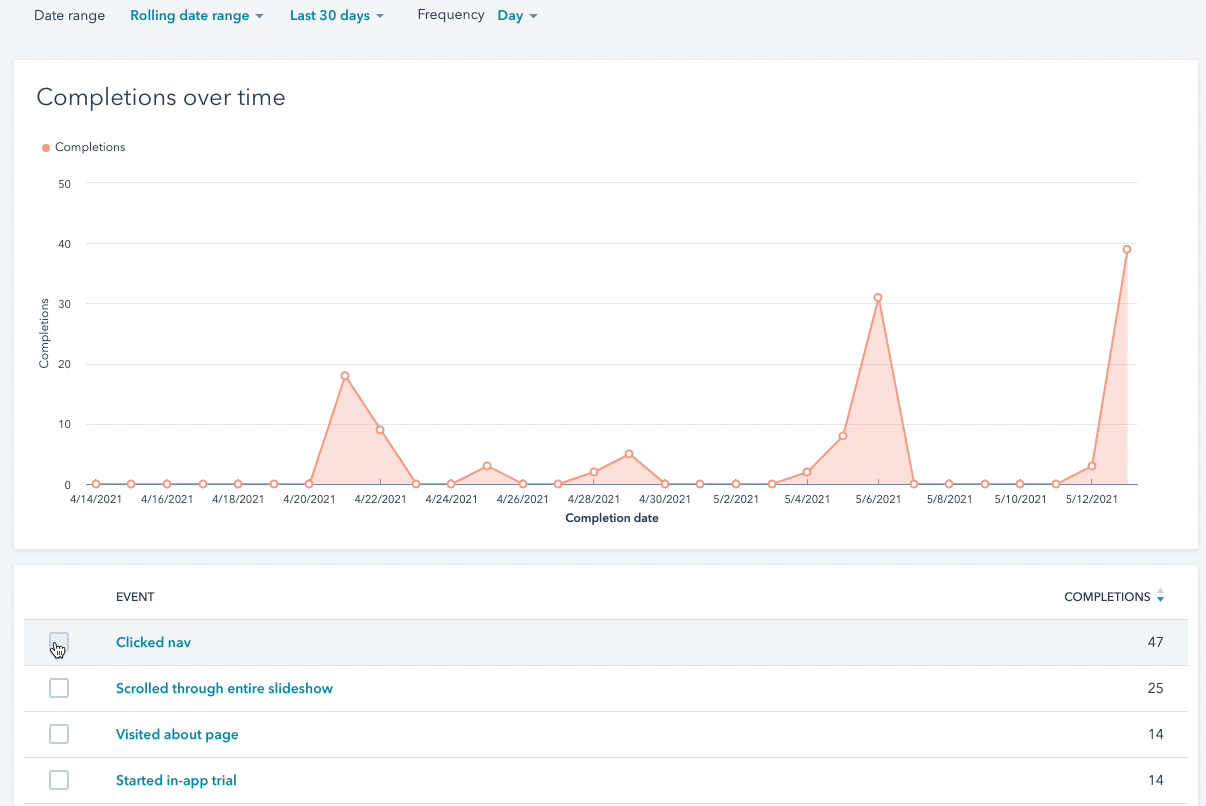- Knowledge Base
- Reporting & Data
- Reports
- Analyze custom events
Analyze custom events
Last updated: November 12, 2025
Available with any of the following subscriptions, except where noted:
-
Marketing Hub Enterprise
-
Sales Hub Enterprise
-
Service Hub Enterprise
-
Data Hub Enterprise
-
Content Hub Enterprise
-
Commerce Hub Enterprise
Please note: this article walks through the new custom events tool, which replaces the previous events tool. Any events created in the legacy tool will continue to work, and you can still manage and analyze those events in the legacy tool.
Event occurrences can be analyzed from the custom events tool, and event data will also be available in the custom report builder and attribution reports.
View event occurrences
- At the top, click the Analyze tab.
- To filter the data for a specific time range and frequency, click the Date range and Frequency dropdown menus.
- If you select a rolling date range, the data set will exclude the current day.
- A week in the report starts on Sunday by default, when the date range selected consists of a week, or when the frequency is set to Weekly.
- To view chart data for specific events in the chart, select the checkboxes next to those events in the table.

- In the table, you can review the following metrics:
- Occurrences: reflects the number of times the event occurred.
- Unique visitors: reflects the number of visitors to the page where the event lives.
- To view more details for an event, including occurrences, unique visitors, and the properties associated with the event, click the name of the event in the table. When reviewing your data, please note the following:
- Not every visitor tied to an occurrence of an event is a contact in your CRM.
- If an anonymous visitor later converts to a contact, HubSpot will retroactively add event data to their contact timeline.
Report on custom events
Using the custom report builder, you can create reports that use custom events as a data source:
- In your HubSpot account, navigate to Reporting > Reports.
- In the upper right, click Create report.
- Select Custom Report Builder.
- To use custom events as your primary data source, click the Primary data source dropdown menu, then select Custom Events.

- If you want to use custom events as a non-primary source, you can select Custom Events from the Other section.

- Continue building your report. To specify which event you want to report on, in the left sidebar, click the Browse dropdown menu, then select Custom Events. Then, under Custom events, select the event you want to report on.
Please note: you can only use data from one custom event per report. Attempting to include properties from multiple events will reset any event fields already in the report.
Use custom events in attribution reporting
In addition to building custom reports, you can also set a custom event as an interaction type for revenue attribution and deal create attribution reporting. To properly attribute revenue to your event, ensure your API call includes the necessary asset types and interaction sources.
To begin tracking event interactions, you must turn on the interaction type in your account settings. Once turned on, your current attribution reports will reprocess to include new event data moving forward. Reports cannot retroactively pull in past event data.
For example, you create an event that tracks when users log in to your mobile app. If a contact who has logged in to the mobile app is later associated with a closed won deal, the login event can be given credit for contributing to that closed revenue.
Please note: it can take up to two days for HubSpot to reprocess existing reports with your event data, depending on the amount of data in your account. .
